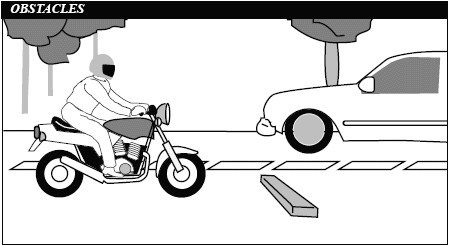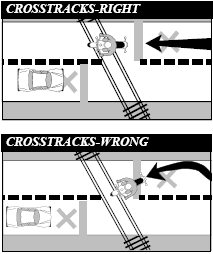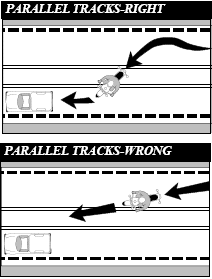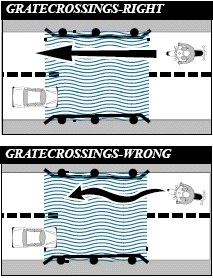Florida Motorcycle Handbook: Handling Dangerous Surfaces
5. Ride within your Abilities
- 5.1. Basic Vehicle Control
- 5.6. Keeping your Distance
- 5.7. Lane Positions
- 5.8. Following Another Vehicle
- 5.9. Being Followed
- 5.10. Passing and Being Passed
- 5.11. Lane Sharing
- 5.12. Merging Cars
- 5.13. Cars Alongside
- 5.14. S.E.E.
- 5.15. Increasing Rider Visibility
- 5.16. Crash Avoidance
- 5.17. Handling Dangerous Surfaces
- 5.18. Mechanical Problems
- 5.19. Unavoidable Hazards
- 5.20. Getting Off the Road
- 5.21. Carrying Passengers and Cargo
- 5.22. Group Riding
- 5.23. Riding While Impaired
Your chance of falling or being involved in a crash increases whenever you ride across:
- Uneven surfaces or obstacles.
- Slippery surfaces.
- Railroad tracks.
- Grooves and gratings.
5.17.1 - UNEVEN SURFACES AND OBSTACLES
Watch for uneven surfaces such as bumps, broken pavement, potholes, or small pieces of highway trash.

Try to avoid obstacles by slowing or going around them. If you must go over the obstacle, first determine if it is possible. Approach it at as close to a 90° angle as possible. Look where you want to go to control your path of travel. If you have to ride over the obstacle, you should:
- Slow down as much as possible before contact.
- Make sure the motorcycle is straight.
- Rise slightly off the seat with your weight on the footpegs to absorb the shock with your knees and elbows, and avoid being thrown off the motorcycle.
- Just before contact, roll on the throttle slightly to lighten the front end. If you ride over an object on the street, pull off the road and check your tires and rims for damage before riding any farther.
5.17.2 - SLIPPERY SURFACES
Motorcycles handle better when ridden on surfaces that permit good traction. Surfaces that provide poor traction include:
- Wet pavement, particularly just after it starts to rain and before surface oil washes to the side of the road.
- Gravel roads, or where sand and gravel collect.
- Mud, snow, and ice.
- Lane markings, steel plates and manhole covers, especially when wet.
To ride safely on slippery surfaces:
- Reduce Speed - Slow down before you get to a slippery surface to lessen your chances of skidding. Your motorcycle needs more distance to stop. And it is particularly important to reduce speed before entering wet curves.
- Avoid Sudden Moves - Any sudden change in speed or direction can cause a skid. Be as smooth as possible when you speed up, shift gears, turn or brake.
- Use Both Brakes - The front brake is still effective, even on a slippery surface. Squeeze the brake lever gradually to avoid locking the front wheel. Remember, gentle pressure on the rear brake.
- The center of a lane can be hazardous when wet. When it starts to rain, ride in the tire tracks left by cars. Often, the left tire track will be the best position, depending on traffic and other road conditions as well.
- Watch for oil spots when you put your foot down to stop or park. You may slip and fall.
- Dirt and gravel collect along the sides of the road - especially on curves and ramps leading to and from highways. Be aware of what's on the edge of the road, particularly when making sharp turns and getting on or off freeways at high speeds.
- Rain dries and snow melts faster on some sections of a road than on others. Patches of ice tend to crop up in low or shaded areas and on bridges and overpasses. Wet surfaces or wet leaves are just as slippery. Ride on the least slippery portion of the lane and reduce speed.
Cautious riders steer clear of roads covered with ice or snow. If you can't avoid a slippery surface, keep your motorcycle straight up and proceed as slowly as possible. If you encounter a large surface so slippery that you must coast, or travel at a walking pace, consider letting your feet skim along the surface. If the motorcycle starts to fall, you can catch yourself. Be sure to keep off the brakes. If possible, squeeze the clutch and coast. Attempting this maneuver at anything other than the slowest of speeds could prove hazardous.
5.17.3 - RAILROAD TRACKS, TROLLEY TRACKS AND PAVEMENT SEAMS
Usually it is safer to ride straight within your lane to cross tracks. Turning to take tracks head-on (at a 90° angle) can be more dangerous - your path may carry you into another lane of traffic.
For track and road seams that run parallel to your course, move far enough away from tracks, ruts, or pavement seams to cross at an angle of at least 45°. Then, make a quick, sharp turn. Edging across could catch your tires and throw you off balance.



5.17.4 - GROOVES AND GRATINGS
Riding over rain grooves or bridge gratings may cause a motorcycle to weave. The uneasy, wandering feeling is generally not hazardous. Relax, maintain a steady speed and ride straight across. Crossing at an angle forces riders to zigzag to stay in the lane. The zigzag is far more hazardous than the wandering feeling.
Check out our Customer Reviews!


